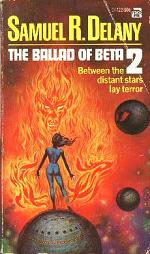
The ballad of Beta 2
Samuel R. Delany
124 pages
published in 1965
Documents referring to this site within the last 24 hours (minimum 2 references):
List referrers to your own site with a single Javascript command (free!): click here.
The Ballad of Beta 2 is one of Delany's earliest novels, after The Jewels of Aptor and the Fall of the Towers trilogy. It is incredibly short, an artifact of first appearing as an Ace Double Novel. This does nothing for the quality of the story, I'm sad to say: it reads more like a plot outline than a proper novel. The Ballad of Beta 2 is a dissappointment compared to The Jewels of Aptor (though I've only read the latter in its 1968, extended edition). Delany is an author who needs some room to work, some space to showcase his qualities and here he just doesn't have that.
Which doesn't mean that this was a complete waste of time to read; I'll gladly read any Delany book I can get my hands on and despite the skeletal plot, there were still a couple of genuine Delany touches that made this worth reading. Heck, any halfway accomplished reader can read this in an hour or two anyway.
The story revolves around anthropology student Joneny, who has reluctantly accepted his teacher's assignment to study the mystery of the Star Folk, the only group of people who ever crossed interstellar space, as the hyperdrive had made this unnecessary. Of the twelve ships that set out from Earth to the Leffer system, only ten arrive and two of those were empty. What could the remnants of these primitive spacefarers teach a galaxy teeming with much richer, much more interesting cultures? Nothing, is Joneny's view; he's convinced they have not contributed one original cultural idea to broader human culture. Unfortunately for him, his professor disagrees and sets him to provide a complete analysis of the Star Folk's best known ballad, the Ballad of Beta 2. It is in this ballad that Delany is able to put his customary cultural touches:
"She walked through the gates and the children cried,
She walked through the Market and the voices died,
She walked past the court house and the judge so still,
She walked to the bottom of Death's Head hill..."
But how does this ballad, with its mentions of cities, sand, sea, markets and courthouses relate to the life on board of these generation ships? And what has it to do with the mystery of the Beta 2 itself, arriving devoid of people after its long journey? Those are the central mysteries of the book, but as I said the length of the novel drasticly limits the depth to which these can be explored. The various questions asked are as quickly solved as they are raised; as if you're reading a sub-Agatha-Christie mystery.
Unlike The Jewels of Aptor then, this is a novel that will only be of interest to people who are already Delany fans. It is very much a journeyman's work, hampered by its short length and with only the occasional flash of Delany's brilliance to make up for it.
